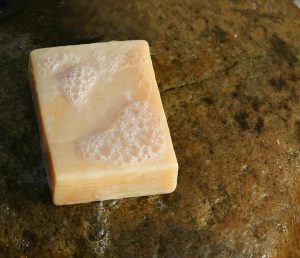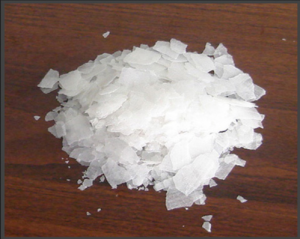Information About Caustic Soda:
“Caustic soda” is a term that might be unfamiliar to those who haven’t worked with industrial chemicals. However, it is a substance used either as an ingredient or in the process of manufacturing dozens of household products (such as body soap, detergents and drain cleaners). Often referred to by its household name of “lye,” which literally means “wash stuff” in Old English, caustic soda has probably been used since the time of the ancient Babylonians and Egyptians, who used it in saponification (the soap-making process).
Caustic soda is a relatively simple man-made chemical compound. It is comprised of one sodium (Na), one oxygen (O) and one hydrogen (H) atom, which is why it’s also referred to as sodium hydroxide bearing the chemical symbol “NaOH.”
Caustic soda is probably the lesser-known product of the Chloralkali process, which is the electrolysis procedure used to free chlorine (Cl) from the sodium chloride (NaCl) found in salt brine. When chemical manufacturers produce chlorine, they also end up producing a comparable amount of caustic soda, which is in many ways as useful as its chemical counterpart.
It is important to recognize that the terms “caustic soda,” “sodium hydroxide” and “lye” all refer to the same chemical compound of NaOH. These terms are used interchangeably throughout the industry and throughout this guide.
Caustic soda is a highly corrosive base or alkaline chemical widely utilized in several different industries. Some common uses include organic chemical production, cosmetic production, soaps & detergent production, paint manufacturing, paper and cellulose, textile bleaching, glass and ceramic manufacturing, food processing, manufacturing rayon, fuel cell production, water treatment, and plumbing (drain cleaners often contain lye).
Caustic soda can cause severe burns to the skin, so it may seem counterintuitive to use lye for making soap. However, sodium hydroxide is one of the few inorganic materials allowed by the USDA in the manufacture of organic soaps. The United States Department of Agriculture (USDA) maintains strict rules over many products grown, raised and produced for human consumption.
The regulations are even more rigorous when the USDA allows a product to bear the distinctive green and white USDA Certified Organic seal on its packaging. Although caustic soda is in no way organic (it’s a man-made chemical product that results from the breaking up of salt molecules), the USDA makes an exception in the production of organic soap. This is because sodium hydroxide is necessary to the chemical reaction that produces soap.
When combined with oils or fats in the saponification process, the caustic soda compound is transformed during the reaction to make the soap safe to use. While the soap acquires some of the atoms once existing in the caustic soda molecule, they are no longer part of the sodium hydroxide compound: the sodium hydroxide and its corrosive properties are gone.
CAUSTIC SODA USEFUL AS A CHEMICAL:

In its natural room-temperature state, caustic soda is a solid, but since it readily dissolves in water, it is often sold and transported as a solution of varying concentrations. When caustic soda is mixed with water or an acid, there is a strong exothermic reaction where heat is released, which can be used as a source of energy to trigger other chemical processes. In many lye-related chemical reactions (as was mentioned with soap) caustic soda gives up its sodium, hydrogen and oxygen atoms to help form new chemical compounds.
In situations where a corrosive substance is required, like for a drain blockage, caustic soda will work to dissolve the organic materials but will leave the PVC pipes intact. Sodium hydroxide is also used in the production of soft drinks, ice cream and food dye. The corrosive and toxic properties of caustic soda disappear in these processes such as the case with soap above.
It’s important to note that sodium hydroxide is not safe for direct consumption. It should never be ingested and can cause severe injury or death. Food companies rigorously train their employees in the safe use of sodium hydroxide in chemical food preparation processes, and the end products are tested before being placed on the market.
TRANSPORTING CAUSTIC SODA:
The transportation of hazardous materials including caustic soda, is subject to overlapping federal, state and local laws and regulations, as well as international regulations. In addition to the legal requirements for transportation of hazardous materials, the laws of nature also place numerous de facto restrictions on the way sodium hydroxide can be safely packaged for transport.
For instance, caustic soda can corrode or react with aluminum and shed hydrogen atoms which becomes an explosive hydrogen gas. Caustic soda should never be stored in aluminum containers for transport or storage. Other metals that interact with sodium hydroxide to produce hydrogen include magnesium, zinc, tin and chromium; caustic soda should never be kept in containers constructed of any of these materials.
Caustic soda doesn’t react with stainless steel making stainless steel drums, tanks and pipelines the standard in the industry. However, caustic soda does interact with some plastics and can corrode the walls of containers or bags constructed of plastic causing dangerous leaks or spills. For this reason, high-density polyethylene (HDPE) barrels and containers are used for packaging.
As was previously mentioned, caustic soda releases thermal energy when mixed with water. For this reason, dry caustic soda should be in airtight containers to prevent moisture from reaching the material. Caustic soda should not be packaged in paper or cardboard, as those materials tend to be both porous and susceptible to combustion.
Liquid sodium hydroxide can be transported in tanks, drums or through pipelines. The same restrictions regarding packaging and container materials apply when caustic soda is being transported in its solid state.
HAZARDOUS MATERIAL CLASSIFICATIONS AND WARNINGS:
In the United States, the Pipeline and Hazardous Materials Safety Administration (PHSMA) creates rules and issues permits for the transportation of hazardous materials:
Placarding
According to the Federal Motor Carrier Safety Administration (FMCSA), sodium hydroxide is aClass 8 (corrosive) hazardous material, meaning vehicles and railcars transporting the substance are required to bear the appropriate placard. The United Nations (UN) number for sodium hydroxide is 1823 for its solid form and 1824 for the liquid caustic soda solution should also be used on the placard. The placard for both forms of caustic soda is a black-and-white standard diamond shape with an image representing a material dissolving a solid mass and burning a hand.
NFPA Rankings
The National Fire Protection Association (NFPA) ranks hazardous materials on a scale of 0 – 4 in three categories. The placards are diamond-shaped and color-coded. Both solid and liquid forms of caustic soda share the following rankings:
Health Risk (Blue): 3 – “Materials that can affect health or cause serious injury, during periods of short exposure, even though prompt medical treatment is give [sic].”
Flammability (Red): 0 – “Materials that will not burn.”
Reactivity (Yellow): 1 – “Materials that are normally stable, but become explosive at elevated temperatures and pressure.”
While NFPA rankings are useful as a quick reference to assess the threats posed by various hazardous materials, they provide less than a complete picture for sodium hydroxide. While caustic acid isn’t flammable under normal conditions when interacting with other materials, it can give off heat or flood the area with volatile hydrogen gas. Either situation can substantially increase the risk of fire or an explosion. Therefore, it is essential for those in the chemical transportation field to be familiar with the properties of each type of hazardous material they carry.


